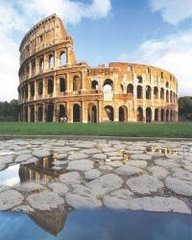Villas and Gardens
Since its most ancient times, Rome has been characterised by the presence of vast green areas. Following the penetration of the Greek culture in the 2nd century B.C., it became the vogue for rich and noble Romans to attach their names to sumptuous gardens, called Horti. These fell into decline with the crisis of the Roman Empire, and only a thousand years later, during the fervour of the Renaissance, did they become one of the most concrete symbols of the return to classicism. Between the 16th and 18th centuries popes, cardinals and aristocrats vied with each other to achieve the richest and most beautiful villas in Rome. Unfortunately, during the 19th century many of these villas were destroyed or altered to make way for the new quarters of Rome the Capital. Nevertheless, today the city is still able to offer numerous hectares of land used as public parks and gardens, where it is possible to take pleasant walks, immersed in nature and history.
The itinerary begins with Villa Doria Pamphilj which with around 180 hectares of land, is the largest of the Roman villas.
The original nucleus was created in the mid-17th century by Camillo Pamphilij, the nephew of Pope Innocent X. The place was chosen because of its closeness to the Vatican (an underground passage was also created, connecting the most important building, the "Casino dell'Algardi", today the seat of the Office of the Prime Minister, with St. Peter's Basilica), the salubrity of the air, and the presence of water. In fact, along the side running along the Via Aurelia Antica, it is still possible to see the arches of the aqueduct built by the emperor Trajan in the 2nd century and restored by Pope Paul V in the early 1600s.
At one point the aqueduct crosses the street with an arch nicknamed "tiradiavoli" (devil puller) because, according to legend, it was here that a carriage driven by devils and carrying the ghost of the sister-in-law of Pope Innocent X, Olimpia Maidalchini, called "la Pimpaccia", would pass by. The name of the terrible woman, hated by the Romans for her wickedness, is also connected with the Fountain of the Snail, which originally was meant to adorn the space in front of Palazzo Pamphilij in Piazza Navona. The woman did not like the lovely shell, carved by Bernini, judging it to be too small and modest, and sent it to the villa outside the city walls, while on the piazza the splendid Fountain of the Moor was installed instead. Coming out through the Porta San Pancrazio, the scene of fighting between the French and Garibaldi's men for the defence of the Roman Republic in 1849, we arrive at the Piazzale Aurelio where, to the left, the Promenade of the Janiculum begins. It was created starting in 1880 and dedicated to Giuseppe Garibaldi, an equestrian monument of whom can be admired in the square carrying his name.
Slightly beyond, his courageous companion Anita is also commemorated, while the 80 busts arranged along the avenues portray heroes from Garibaldi's campaigns. From the square, every day at noon, the hour is "announced" with the firing of an Austrian-Hungarian cannon dating from World War I.
In addition to enjoying one of the most spectacular views of the city, in Piazzale Garibaldi both old and young can spend moments of fun watching the Teatrino di Pulcinella, the amusing Punchinello's puppet show, held every afternoon from 4 to 7 p.m., and on Saturday and Sunday mornings from 10.30 a.m. to 1 p.m.
For plant lovers, we recommend a visit to the "Orto Botanico" (Botanical Gardens).
The gardens originate from the garden for the cultivation of medicinal plants created in the Vatican by Pope Nicholas III in the late 13th century. The present-day botanical gardens were established in 1883 and contain over 3,500 cultivated species.
It is possible to admire the enormous plane-tree that, with its age of 350-400 years, is one of the oldest in Rome, or the bamboo collection, one of the most important in Europe. Particularly noteworthy is the Garden of Fragrances, created for the blind, with plants that can be perceived through the senses of touch and smell.
From Piazzale Aurelio we go along the Via delle Mura Gianicolensi, characterised by the powerful 17th-century city walls along it, until we reach Via Calandrelli, where at no.26 we find the entrance to Villa Sciarra.
In the early 19th century the last owners, Mr. and Mrs. Wurts, transformed the park into a true paradise, full of rare plants and embellished with an original sculptural decoration coming from an 18th-century Lombard villa. The enchanting place charmed and fascinated Gabriele D'Annunzio, who set the duel of Andrea Sperelli, the protagonist of his novel Il piacere, there. After crossing the Tiber, continuing along the Lungotevere Aventino, we meet on the right the Clivo di Rocca Savelli, a picturesque staircase leading directly into the little garden that extends over the area where the fortress of the Savelli family stood in the Middle Ages. The park is more well known as the Garden of Orange Trees.
The citrus fruit plants in it were placed here in 1932 in commemoration of the Spanish orange tree brought to Rome by St. Dominic in 1220. This tree, according to tradition the first planted in Italy, still miraculously exists in the garden of the monastery of Santa Sabina and can be seen through a hole in the wall of the church portico. At the end of Via di Santa Sabina, descending towards the Circus Maximus, we find the Municipal Rose Garden, one of the most beautiful in the world, also thanks to the scenic context in which it stands.
The place was used as the Cemetery of the Roman Jewish Community from 1645 to 1934, the year it was decided to change the area into a public park. The secular cypresses presently lining the Via del Circo Massimo recall the old use of the park. The rose garden was founded in 1950 but, to sanction the bond that unites it to the Roman Jewish Community, two steles, reproducing the tablets of Moses, are arranged at the entrances of the two sectors, while the avenues, as can be seen from atop the central staircase, were designed in the form of a menorah, the seven-branched candelabrum symbolising the Jewish religion.
After descending along the Via del Circo Massimo, and crossing Piazza di Porta Capena, we go up to the Caelian Hill where, on Via della Navicella, we find the entrance to Villa Celimontana, created in the 16th century by the noble Mattei family.
In the past its fame was great not only because of the beauty of the place, but also because of a custom started by St. Philip Neri in 1552: during the pilgrimage to the seven Jubilee basilicas, it was customary to stop at the villa, where the Mattei family would offer the pilgrims a snack. It is said that, in 1668, 6,000 persons participated. The main building of the villa, today the seat of the Italian Geographic Society, is adorned with 17th-century frescoes and precious Roman mosaics found in the zone. To the left of the building, not very visible because of a fence and scaffolding which have concealed it for many years now, is a small obelisk from the time of Pharaoh Ramses II (13th-12th century B.C.), which was once the greatest attraction of the villa. The obelisk, found on the Capitoline Hill, was donated by the City of Rome to Ciriaco Mattei in 1582, thus gaining the peculiar distinction of being the only obelisk in a private collection.
If you would like to take a lunch break, you might go to Via Ostilia where, at no. 23, you will find Isidoro al Colosseo (06 70493462). The restaurant offers its clients 23 "tastes" of different first-course dishes!
To conclude the long walk, we can visit Villa Borghese, which can be reached with the underground.
It is one of the most renowned villas in Rome, ordered by Cardinal Scipione Borghese in the early 17th century. The Roman poet Belli praised the generosity of the prince who, in the late 19th century, allowed the people to gather in the large Piazza di Siena for the famous "Festa dell Ottobrate", during which there was singing, dancing, and food to eat. The most romantic place on the villa grounds is undoubtedly the lake with its little island dominated by the Temple of Aesculapius, the god of medicine, erected in Ionian style in the late 18th century and embellished with an ancient statue of the god. A modern overpass connects the villa to the Pincio, the first public garden planned in Rome as desired by Napoleon, who would have liked to celebrate himself in the new Jardin du Grand César.
As suggested by Mazzini, 224 busts of famous persons were installed throughout the park, but they have been, and still are, too often the targets of vandalism. At the base of the bust of astronomer Angelo Secchi there is a small hole through which Rome's meridian passes. Another small obelisk, found in the zone of Porta Maggiore, stands along one of the villa's avenues. Unlike most of the Roman obelisks, it does not come from Egypt, but was created in Rome for the emperor Hadrian, who dedicated it to his beloved Antinous.
From the Pincio, terrace, dedicated to Napoleon I, it is possible to admire another renowned view of Rome, with the dome of St. Peter's Basilica in the background.
Taking the ramp of the Pincio we do down to the Piazza del Popolo, where we can have an aperitif at Canova or Rosati, historic cafés of the capital, or eat dinner at Bolognese (06 36 11426), to try their famous tagliatelle.
Practical suggestions: It is advisable to wear comfortable shoes and clothing. Along the itinerary it is not easy to find bars or refreshment stands, so it is a good idea to bring along snacks and beverages.
Addresses: Botanical garden Largo Cristina di Svezia 24 - 00165 - tel. +39-6-68 64 193. Hours: Monday-Saturday 9.30 a.m.-4 p.m. (winter hours); Monday-Saturday 9.30 a.m.-7 p.m. (summer hours). Admission fee.
Municipal Rose Garden, Via dei Pubblici 3 - 00153 - tel. +39 6 5746810. The rose garden is open throughout the period the roses are in bloom. Free of charge.












